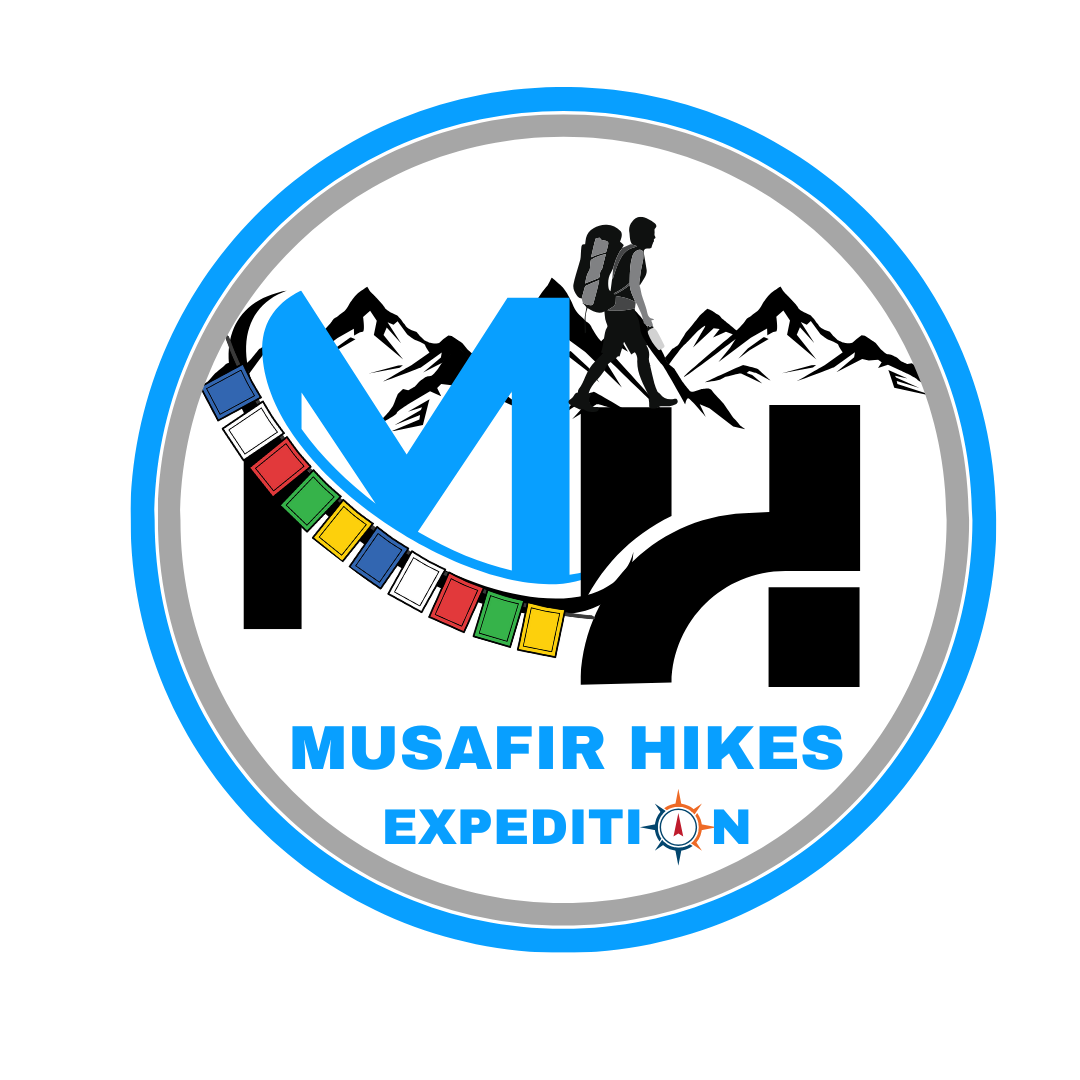Region
Uttrakhand | India
Duration
5 Days
Max. Altitude
12,500 ft.
Trekking Km.
23 kms
Grade
Easy To Moderate
Get in Touch with Our Trek Expert
- 91-9634395113
- info@musafirhikes.com
- Monday - Saturday: 10 AM to 06 PM
Rs. 6,500 /Person
Fixed Departure Dates
Sept 2025
- 5% GST will be applicable on Trek Cost and Add-ons.
- Meeting Point( Pickup/ Drop Point ): Hotel Milan Palace near Railway Station,Dehradun.
- Reporting Time: 6:00 am
- Drop Time: 6:30 pm to 7:30 pm (Timings are subject to change based on weather and road conditions).
- Please reach Dehradun a day before to avoid any delays.
Overview
For the people who are in search of perfect adventure and thrill then Kedarkantha trek is the one for you. Situated in the mighty Himalayas, Kedarkantha peak stands high at an altitude of 3,800 m overlooking many other high Himalayan peaks. The region offers outstanding landscape marked with exquisite mountains, holy lakes, rivulets and lofty peaks.
The Kedarkantha trek starts from a charming village “Sankri” which is perched in the Uttarkashi district. Thus, it adds some more magic to the prettiness of this trek. So, reach there and get welcomed by the panorama perspective of fable Himalayan summits. Moreover, the friendly villagers and rich culture is enough to attract any explorer and give experiences of a lifetime.
Therefore, Kedarkantha turns out to be the best Himalayan trek in Uttarakhand. Especially, it’s a great winter trek offering surpassing beauty and great adventure.
Exhilarating Summit Climb and 360 Degree View
Continue Reading....
Experiencing yourself at the top of a summit feels like being at top of the world. That experience is special and words aren’t enough to define it. Now, get this kind of joyous experience on Kedarkantha trek even if you are a beginner and enjoy the thrills.
The terrain is steep but the challenging climb will reward you with the best views of majestic peaks. And, if you are thinking about taking your children or coming with your families then without any doubt you can choose the Kedarkantha trek.
The peaks visible from Kedarkantha top are Swargarohini, Bandarpoonch, Black peak, Kinnaur ranges, Yamunotri and Gangotri ranges. This panorama of Himalayan peaks is truly jaw-dropping.
Verdant Forests and Cosmic Meadows
The forests are dense and the trail passes through them. During your trek, you will come across lush greenery and flora. If lucky, then you can spot some Himalayan animals. There are also some amazing forest clearings like Juda Ka Talab which is a perfect campsite too.
The wide meadows with heart-warming views are present here which are hard to find on other treks of the same altitude.
Explore the Culture
The perks of choosing Kedarkantha trek is exploring the Himalayan culture, traditions and directly communicating with the villagers. The people there speak different languages, wear different clothes and are very friendly.
The people of Sankri mainly grow rice, apples and potatoes here and the most beautiful part about this quaint village is people still live in wooden houses which protect them against the chilling cold. Due to strong belief in mythology and religion the fairs are organized regularly and folk dance is performed.
There you can try traditional food, watch their beautiful folk dance and learn about mythological tales, as most of the places in Uttarakhand are related to mythology.
Who Can Participate
- Age Requirements:
- April to November: 9 years.
- December to March: 11 years.
- First-timers are welcome, though prior trekking experience is preferred. Good fitness is a must.
- Fitness Criteria:
- The Trekker should have sufficient stamina to cover 5 km of distance by jogging in 35 minutes without stress or 10 km of distance in 80 minutes without stress
- If the trekker prefers cycling he/ she should be able to cycle 10 km of distance in 30 minutes .
- If the trekker wants to carry a backpack then he/she should be able to carry a 10-12 kg backpack. If opt Off-load option then the trekker should be able to carry a 3-5 kg backpack.
- If a trekker’s BMI is more or less than the normal range (18-29), please consult our Trek Coordinator before booking.
Kedarkantha Trek Itinerary
DAY 1
Dehradun to Sankri
Distance: 220 km
Driving Time: 9-10 hours
Altitude: 1,920 m
DAY 2
Sankri to Juda Ka Talab
Trek Distance: 04 km round trip
Altitude: 2,774 m
DAY 3
Juda Ka Talab to Kedarkantha base
- Distance: 04 km
- Altitude – 3,430 m
DAY 4
Kedarkantha base to Kedarkantha peak and stay in Hargaon Thach
- Distance: 06 km
Altitude :
- Kedarkantha Peak:-3,800 m
- Hargaon Thach:- 2,713 m
DAY 5
Hargaon Thach to Sankri and return to Dehradun
- Trek Distance: 06 km
- Drive Distance: 220 Km.
Trip Ends: Arrival in Dehradun by evening
Dehradun to Sankri
Distance: 220 km
Driving Time: 9-10 hours
The Kedarkantha trek starts from Dehardun. The trekkers will have to reach there before 6:30 am for a picturesque journey to basecamp i.e. Sankri. The scenic drive is through adventurous Himalayan roads, enjoy amazing long drive and in middle of your journey halt for lunch.
Sankri is a busy village in Govind Wildlife Sanctuary of Uttarakashi at a distance of 220 km from Dehradun. Reach there in the evening and get in pre-booked hotel. Now, in leisure time explore the mesmerizing village. Sankri market is a busy but beautiful place with some shops owned by locals and there are few restaurants too.
The connectivity is poor in this region but there are irregular signals of BSNL and Vodafone. However the exquisite nature and setting sun which turns the Himalayan peaks golden is a heart-warming sight to cherish. Afterwards return to the hotel and stay there for the night
Sankri to Juda Ka Talab
Trek Distance: 04 km
Trek Time: 4–6 hours.
Difficulty Level: Moderate
Altitude:2,774 m
The trekking starts from Sankri today and the journey to Juda Ka Talab is 4 km long. So, start early after having breakfast because reaching there would approximately take 5 hours. Start the journey, leave Sankri and cross a village named Saur.
Now, the steep climb starts. The trail moves along the flowing stream which heads to Kedarkantha. Now, the ascent is via thick forests of pine and maple through many bridges. It is the beautiful surroundings that will surely leave all awestruck. The path is broad and only the sounds of gushing streams can be heard.
During your trek you can see some quaint villages and some villagers doing their household chores. On the way you can also spot some Himalayan Langoors and other animals in the jungle. But, the forests are also home to hares, martens and boars so they can also be seen here. After few stream crossing and continuing trekking through the dense forest you can reach one of the best campsites in Uttarakhand, Juda Ka Talab.
It is a unique forest clearing with a big glacial lake amid dense forest which is a perfect camping spot. At night feast your eyes with the glorious sight of the sky sparkling with shimmering stars making the camping more lovable. The stay will be in tents today.
Juda Ka Talab to Kedarkantha Base
Trek Distance: 04 Km
Altitude: 3,340 m.
The journey continues where the trekking will be towards the base of Kedarkantha. Today the trail is straight and visible; the distance from Juda Ka Talab to Kedarkantha Base is 4 km which can be easily covered in approximately 3 hours.
The initial trek starts with a steep climb through dense forest of oak and pines. Throughout the journey some shepherd huts will be visible in the wide meadows which are a delight to watch. In the middle of your journey stop and relax to enjoy the serene aura of nature. After a break head towards the base and just before reaching get striking views of Black peak, Swargarohini, Ranglana and Bandarpoonch.
After you reach the base, pitch your tents in the desired place and relish the exciting views. At the evening do not miss to watch the cluster of stars making the aura more charming. But, the campsite is windy so be covered with woolen layers and protect yourself against cold. Spend your night in tents.
Kedarkantha base to Kedarkantha peak and stay in Hargaon Thach
Trek Distance: 06 Km
Altitude:
- Kedarkantha peak: 3,800 m.
- Hargoan Thach: 2,713 m.
Start the journey early because it’s going to be a long but exciting day with thrilling adventure. Watch the bewitching sunrise from the meadows of Kedarkantha and get energized for the journey ahead. The peak is clearly visible which pushes the adrenaline rush.
There are many trails to reach the top but it’s good to choose the main even trail. The path is again through forest cover and when you come close to the top; the ascent becomes steep and strenuous. But, the panorama views of rising peaks from the Kedakantha top is highly rewarding and worth your efforts.
Reach the top after a tiring hike and the presence of beautiful temple of Lord Shiva, Parvati and Ganesha will boost up your energy. Not only presence of the temples but also the panoramic sight of snow covered peaks is exquisite.
Spend some time there relaxing, and then get ready for a descent to Hargaon. Take the same trail through forest of pines, maples and oak trees by passing through some surprising forest clearings. Reach Hargaon, and enjoy spending the night there in camps.
Hargaon Thach to Sankri and return to Dehradun
Trek Distance: 06 Km
Altitude: 1,920 m
Drive Distance: 220 Km.
Today the journey is towards Sankri which will take around 4 hours. Wake up early and witness the mesmerizing sunrise from Hargaon campsite. Afterwards have breakfast and bid goodbye to this magical place.
The trail is well marked descending through a wealthy forest of pines, the stream flows on side which can be clearly seen. Further from the ridge you get a beguiling view of Har Ki Dun valley which is also known as “The Valley of Gods”. Continue descending and you will reach Sankri between 11;00 am to 12:00 pm and plan to return to Dehradun.
Note: Read more about our Customize Tours Plan before booking your tour.
The Kedarkantha Trek is one of the most popular Himalayan treks and can be done almost year-round. However, each season offers a unique experience—ranging from snow-filled adventures to meadow walks and crisp autumn skies.
Best Time for Beginners
If you’re a first-time trekker, the ideal months are March–April or October–November. The weather is moderate, trails are friendlier, and you’ll still get to enjoy snow patches or clear summit views without extreme conditions.
Here’s what you can expect in different seasons:
Winter (December to February): The Classic Snow Trek
This is the most iconic season for Kedarkantha. The entire trail is covered in thick snow, creating a true winter wonderland. The summit climb, with snow-laden pine forests and 360° views of white peaks, is unforgettable.
Highlights: Heavy snow, frozen lakes, pine forests draped in white, magical summit views.
Best for: Adventure seekers, photographers, and those wanting the true “snow trek” experience.
Spring (March to April): Snow Meets Blossoms
As the snow begins to melt, meadows re-emerge and rhododendrons bloom across the slopes. The contrast of melting snow patches against fresh flowers makes this a scenic and less crowded time to trek.
Highlights: Snow patches, blooming rhododendrons, moderate temperatures.
Best for: Beginners and nature lovers who want both snow and colors.
Summer (May to June): Clear Trails and Alpine Meadows
The weather is stable, skies are clearer, and trails are fully open. Meadows turn lush green, and the trek becomes easier without heavy snow. This is also when the region is alive with local village activity.
Highlights: Clear mountain views, green meadows, warm days with cool nights.
Best for: Families, beginners, and trekkers who prefer non-snow conditions.
Monsoon (July to September): Misty Forests and Rich Greenery
The region receives moderate to heavy rainfall. Meadows and forests turn a deep green, and streams run full. While trails can get slippery, the valley looks mystical in monsoon fog.
Highlights: Misty landscapes, rain-washed forests, fewer crowds.
Best for: Trekkers who enjoy solitude and don’t mind trekking in wet conditions.
Autumn (October to November): Crisp Views and Golden Forests
After the rains, the skies are clearest, offering sharp views of Swargarohini, Bandarpoonch, and Black Peak. Forests take on golden and amber shades, making the trek extremely photogenic. Early snow sometimes arrives in late November.
Highlights: Clear skies, autumn colors, panoramic Himalayan views.
Best for: Photographers, mountain lovers, and those seeking quieter trails before winter rush.
Kedarkantha Trek Map
Trek Guidelines
Health & Awareness
All participants must undergo a mandatory health check-up before the trek, as per Indian Mountaineering Foundation (IMF) safety norms.
Trekkers with chronic medical conditions (e.g., asthma, heart disease, epilepsy, diabetes, high blood pressure) must declare them during registration and carry prescribed medicines.
Basic first aid, oxygen cylinders, and a certified trek leader trained in Wilderness First Aid (WFA) will be present on all expeditions.
Trekkers must be aware of Altitude Mountain Sickness (AMS), its symptoms, and precautions. Guidelines will be explained during the briefing session.
Government Employees
As per Indian Government rules, employees availing leave for adventure activities must ensure proper leave sanction orders from their department before joining the trek.
Employees seeking reimbursement or recognition for adventure training must ensure the trek is recognized by the Indian Mountaineering Foundation (IMF) or Ministry of Youth Affairs & Sports.
A participation certificate will be provided after the trek, which can be submitted to concerned government departments for official use.
It is the participant’s responsibility to comply with their organization’s travel, safety, and insurance policies before joining.
Kids Guidelines
Children below 10 years are generally not recommended for high-altitude treks as per IMF advisory.
For family-friendly treks, children aged 10–15 years must be accompanied by a parent/guardian and require a fitness clearance certificate from a registered doctor.
Kids must be mentally prepared for long walks, uneven terrain, and basic camping conditions, as per outdoor safety norms.
Parents/guardians are solely responsible for their child’s safety, behavior, and adherence to trek rules.
Fitness Required
All trekkers must meet basic fitness standards set under Indian Mountaineering Foundation (IMF) and Ministry of Tourism guidelines.
Minimum fitness requirements:
Ability to walk 5 km in 45 minutes on plain terrain.
Ability to carry a 6–8 kg backpack for multiple hours.
No recent major surgeries or serious medical conditions in the past 6 months.
A medical fitness certificate (from an MBBS/MD doctor) is mandatory before joining high-altitude treks.
Alcohol, smoking, and drug use are strictly prohibited during the trek as per IMF and local administrative regulations.
What To Pack
Shoes and backpack
- Trekking shoes with ankle support
- Backpack with rain cover
Warm Layers and Clothes
- Warm layers – 3 layers if you’re trekking in spring, summer and monsoon (1 woollen sweater, 1 fleece, 1 padded jacket) – 4 layers if you’re trekking in autumn (1 woollen sweater, 2 fleece, 1 padded jacket) – 5 layers if you’re trekking in winter (1 pair of thermals, 1 woollen sweater, 2 fleece, 1 padded jacket)
- 3 Collared T-shirts (Wear one, carry two)
- 2 quick-dry trek pants (Wear one, carry one)
Continue Reading..
Accessories
- Sunglasses
- Sun cap
- Waterproof gloves
- Balaclava
- Woollen socks (2 pairs of Dry fit + 1 pair of Woollen)
- Headlamp
- Trekking pole
- Rain jacket + pants / poncho
Toiletries:
- Sunscreen
- Moisturiser
- Light towel
- Lip balm or vaseline
- Toilet paper
- Toothbrush
- Toothpaste
- Reusable plastic covers (for used clothes)
Cutlery:
- Steel lunch box, spoon and a Two water bottles or Hydration Pack
Basic Medical Kit (Carried by You)
While Musafir Hikes carries a larger medical kit, we recommend bringing personal medicines:
- Diamox (for AMS) – only after doctor consultation
- Paracetamol, Combiflam
- Avomine (for motion sickness)
- ORS or Electrolyte Sachets
- Band-aids, Antiseptic Cream
- Muscle Spray or Pain Relief Balm
- Any prescribed medication
Documents & Personal Items
- Government ID (Aadhar/Passport) – Mandatory for forest permits
- Photocopies of ID – At least 2
- Passport-size Photos – 2–4 (for permits)
- Cash – ATMs may not work beyond Joshimath; keep ₹2,000–₹3,000 for local expenses
- Small Notepad + Pen – For journaling or information
Pro Tips
- Pack light but don’t skip essentials. Every extra kilo will feel heavier at 3,500 m.
- Avoid plastic bags. Use dry bags or zip-locks to keep items dry and organized.
Check weather forecasts a day before your trip and adjust accordingly.
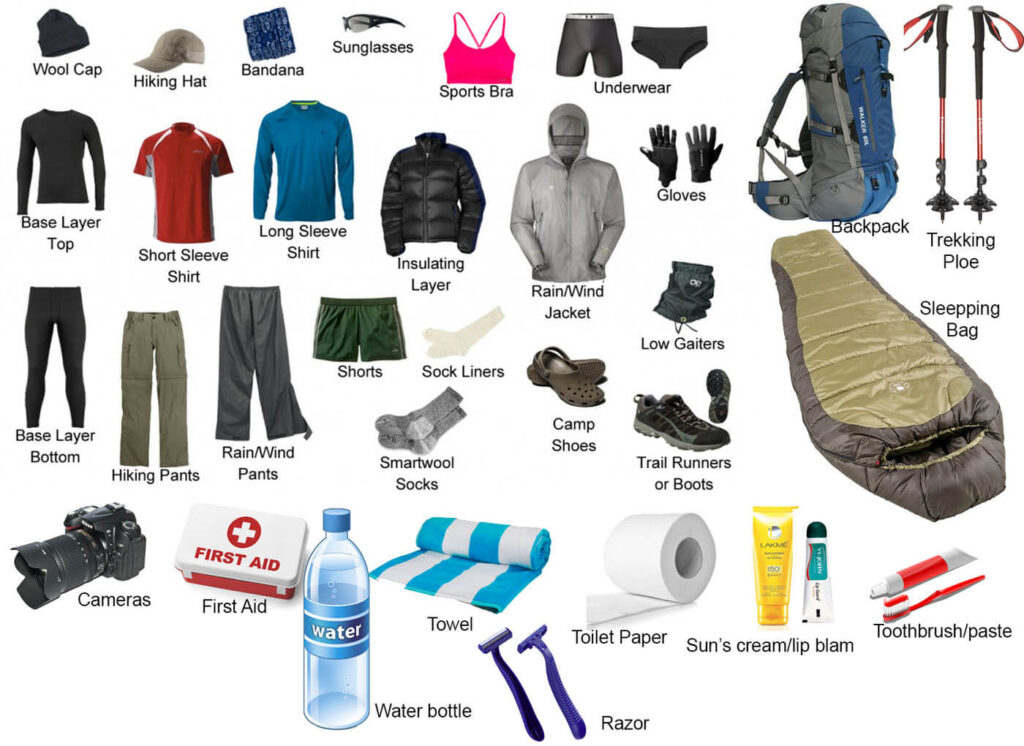
How To Reach
Pick-Up Information
- It is essential for everyone to arrive at Dehradun (06:00 am)
- Pick-up Location – Hotel Milan Palace near Railway Station,Dehradun.
- Once you have reached Dehradun, MHE will manage the rest of your travel arrangements, if you have opted for pick-up service, you can select this option during the booking process by adding it as an add-on.
Options to Reach Dehradun
First, you can arrive at Delhi, Dehradun airport or Chandigarh. The journey from these locations to Dehradun is explained below.
1. Take overnight train/bus to Dehradun.
2. Take overnight train/bus to Haridwar and drive to Dehradun (50km | 1 hr 30 min drive with normal traffic).
3. Take overnight train/bus to Dehradun.
4. Board a flight to Dehradun airport (Jolly Grant Airport) (26 km, 30 min) from Dehradun. If you’re arriving by air, then come one day in advance.
Drop-Off Information
- The designated drop-off point is same as pickup point.
- Reach in Dehradun by 6:30 to 7:30 pm.
- Please consider planning your subsequent travel arrangements after 10:00 pm.
Note – In July and August month always have a buffer day in your Itinerary due to the Monsoon.
- It’s highly advisable to keep a buffer day in your travel plan. If the buffer day is not used, it can be used to explore Dehradun/Rishikesh.
- MHE offers comfortable transportation through Tempo Traveler, Bolero, or equivalent vehicles. If you wish to upgrade your mode of transportation, please contact your trek coordinator for further assistance.
Cost Terms
✅Inclusion
Accommodation (as per the itinerary):
- Triple/quad sharing (separate for males and females throughout the trek)
Meals (Veg + Egg):
- All meals (including tea, soup, snacks, etc.) from Day 1 Dinner to Day 3 Breakfast. Morning and evening tea, accompanied by light snacks, are included in the Tungnath-Chandrashilla trekking package.
3. Support:
- 1 Versatile base camp manager handles communication and deploys extra manpower in emergencies.
- 1 Mountaineering & First aid qualified professional trek Leader.
- 1 Experienced high-altitude chef.
- Local experienced guides (Number of guides depending on the group size).
- Enough support staff.
Trek equipment:
- Sleeping bag, Sleeping liners (if required), mattresses, and Utensils.
- 3 men all season trekker tent (twin sharing), Kitchen & Dining tent, Toilet tent.
- Camping stool, Walkie talkie.
- Ropes, Helmet, Ice axe, Harness, Gaiters & crampons (if required).
5. First aid:
- Medical kit,Stretcher,Oxygen cylinder,Blood pressure monitor,Oximeter,Stethoscope.
6. Transportation (as per the itinerary). Mules/porters to carry the central luggage.
- Cloakroom facility available at the base camp for additional luggage
- All necessary permits and entry fees, Upto the amount charged for Indian
- Trek Completion Certificate.
❌Exclusion
- Insurance (Mandatory).
- Food during the transit.
- Any kind of personal expenses.
- Mule or porter to carry personal luggage.
- Emergency evacuation, hospitalization charge, etc.
- Anything not specifically mentioned under the head Inclusion.
Things can be provided on demand and availability (participant has to pay extra for these things).
- Satellite phone/set phone – is a type of mobile phone that connects via radio links via satellites orbiting the Earth instead of terrestrial cell sites like cellphones. Therefore, they can operate in most geographic locations on the Earth’s surface.
- Gamow/PAC HAPO Bag(Portable Hyperbaric Bag) – is a unique, portable hyperbaric chamber for the treatment of acute mountain sickness (AMS), also known as altitude sickness.
- AEDs (Automated External Defibrillators) are portable life-saving devices designed to treat people experiencing sudden cardiac arrest, a medical condition in which the heart stops beating suddenly and unexpectedly.
Cancellation & Rescheduling Policy
We understand that plans can change. Our policies are simple, transparent, and designed to balance your flexibility with the commitments we make to our local teams.
 Cancellation Policy
Cancellation Policy
- Cancellation requests must be made in writing via email (info@musafirhikes.com)
- The date of cancellation is the date we receive your request, not when it is sent.
Refunds
- 30+ days before trek → Full refund (minus 1.99% processing fee)
- 15–29 days before trek → 80% refund
- 10–14 days before trek → 60% refund
- 5–9 days before trek → 40% refund
- ≤4 days before trek → No refund
Rescheduling Policy
- Requests must also be made in writing (e.g., via email).
- The date of receipt determines rescheduling eligibility.
Rescheduling Fees
- 30+ days before trek → Free reschedule
- 15–29 days before trek → 10% fee
- 10–14 days before trek → 20% fee
- 5–9 days before trek → 30% fee
- ≤4 days before trek → Not possible
Notes
- Refunds are processed within 7–10 business days to the original payment method.
- Timelines are counted from the original trek start date.
- If a trek is affected by weather, natural events, or government restrictions, we will try to reschedule first. If not possible, the cancellation terms above apply.
- Bookings are non-transferable.
- Once rescheduled, treks become non-refundable.
Trek Essentials
Gallery
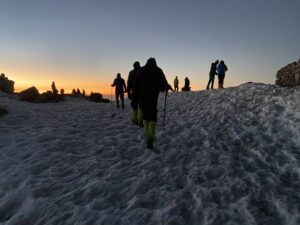
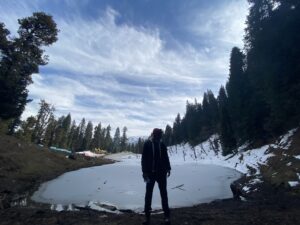
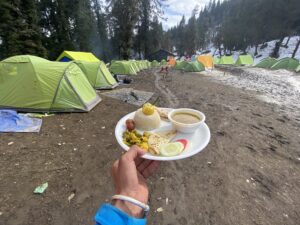
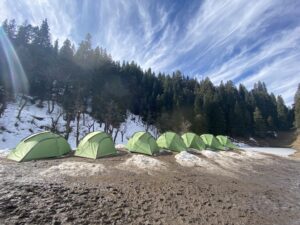
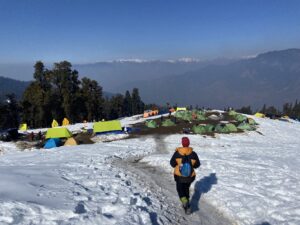
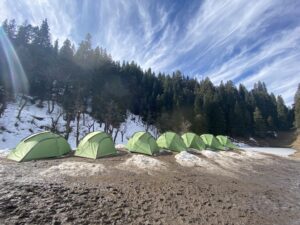
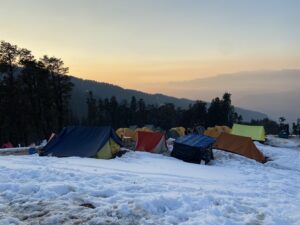
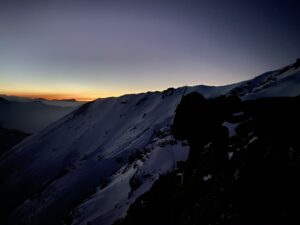
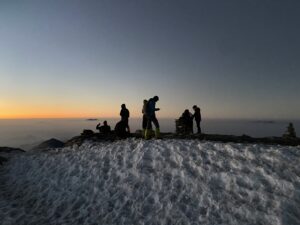
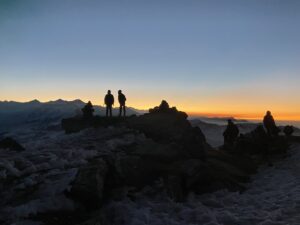
Frequently Asked Questions(FAQ)
What is the best time for the Kedarkantha trek?
Kedarkantha is ideal as a winter trek, transforming into a snow-covered wonderland during this season.
When can I expect snow?
Snowfall typically occurs from December to April, with occasional light snow before December.
What if it rains during the trek?
Tents are waterproof. Use a rain cover for your backpack and a poncho to stay dry.
How many people share a tent?
Tents are provided on a twin-sharing basis, with the option for triple occupancy if required.
When can I expect snow?
Snow is usually present from late December to early March.
Where is the last ATM point, and what about network connectivity?
- Last ATM: Purola
- Network: Limited and intermittent; BSNL and Vodafone may work at Sankri.
Are washroom facilities available during the trek?
Yes. Guesthouses at Sankri have basic washrooms. During camping, toilet tents (dry pits) will be provided separately for men and women.
Is there a place to leave luggage I don’t need during the trek?
Yes. You can leave extra bags or items at Hotel, safely stored until your return. Just pack a smaller bag with essentials for Ghangaria and trail days.
Do I need any permits for the trek?
Yes, forest entry permits for the Kedarkantha trek.These are arranged by Musafir Hikes as part of your trek package. You only need to bring a government ID and passport-size photos.
Can trekking equipment be rented?
Yes, jackets, trekking shoes, hiking poles, and backpacks are available for rent.
Where will we stay during the trek?
- Day 1 & Day 5: Hotel Himalayan Bliss, Sankri
Trekking Days: Tented accommodations
How do I book a tour with Musafir Hikes?
You can book directly through our website or contact us via call/WhatsApp/email. Once you select your tour, you’ll receive a confirmation and payment details.
What is included in the tour cost?
Our tours generally include accommodation, meals (as per itinerary), guide charges, permits, and basic medical support. Exclusions usually cover personal expenses, travel insurance, and anything not mentioned in inclusions.
Is it safe to travel with Musafir Hikes?
Yes. Your safety is our top priority. We follow government trekking norms, carry first aid, and our guides are trained in mountain safety and emergency handling.
How difficult is the trek/tour? Do I need prior experience?
Difficulty varies from tour to tour. Most treks are designed for beginners with good fitness, while some require prior high-altitude experience. Fitness preparation tips are always shared after booking.
How do I prepare physically for the trek?
We recommend regular walking/jogging, stair climbing, or light cardio at least 3–4 weeks before the trek. Staying hydrated and building stamina will make your experience much easier and enjoyable.
How do I reach the starting point of the trek?
We provide details of the nearest railway station/airport and assist with travel planning. Transport from pickup points (like Rishikesh/Dehradun) is usually arranged with the group
Why should I choose Musafir Hikes?
We focus on safety, sustainability, and local community support. A part of your booking helps uplift Himalayan villages, making your journey meaningful.
